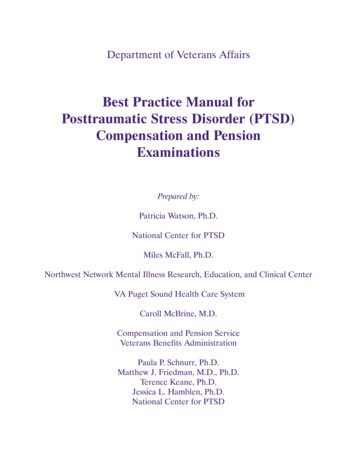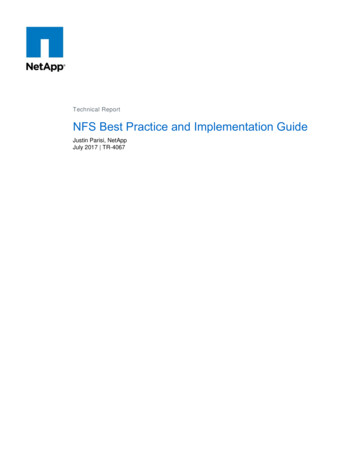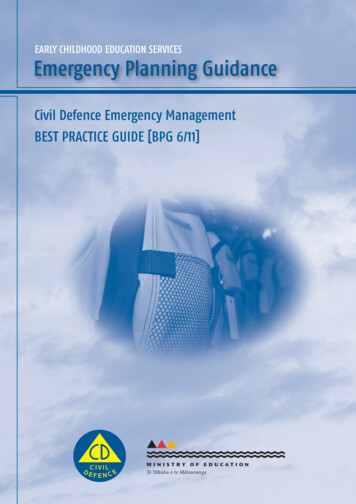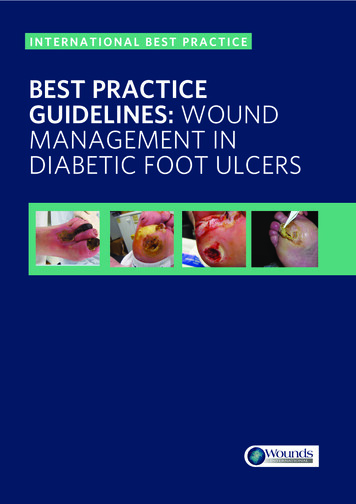
Transcription
Department of Veterans AffairsBest Practice Manual forPosttraumatic Stress Disorder (PTSD)Compensation and PensionExaminationsPrepared by:Patricia Watson, Ph.D.National Center for PTSDMiles McFall, Ph.D.Northwest Network Mental Illness Research, Education, and Clinical CenterVA Puget Sound Health Care SystemCaroll McBrine, M.D.Compensation and Pension ServiceVeterans Benefits AdministrationPaula P. Schnurr, Ph.D.Matthew J. Friedman, M.D., Ph.D.Terence Keane, Ph.D.Jessica L. Hamblen, Ph.D.National Center for PTSD
iiPost-Traumatic Stress Disorder
Compensation and Pension ExaminationsCONTENTSExecutive Summary. . . . . . . . . . . . . . . . . . . . . . . . . . . . . . . . . . . . . . . . . . . . . . . . 1CORE DOCUMENTI. Background Information: PTSD Initial Claims Review . . . . . . . . . . . . . . 5II. Background Information: Assessment of PTSD. . . . . . . . . . . . . . . . . . . 7III. Recommended Guidelines for AssessingTrauma Exposure and PTSD . . . . . . . . . . . . . . . . . . . . . . . . . . . . . . . . . . 13IV. Compensation and Pension PTSD disabilityexamination worksheets. . . . . . . . . . . . . . . . . . . . . . . . . . . . . . . . . . . . . . 23A. Worksheet I: Initial Evaluation for PTSD . . . . . . . . . . . . . . . . . . . . . 23B. Worksheet II: Review Evaluation for PTSD . . . . . . . . . . . . . . . . . . . 31V. Suggested Report Template for Initial Exam . . . . . . . . . . . . . . . . . . . . . 37VI. Suggested Report Template for Follow-up Exam . . . . . . . . . . . . . . . . . . 47APPENDICESA. Training Letter Based on PTSD Case Review . . . . . . . . . . . . . . . . . . . . 55B. Governing Regulation for Service Connection for PTSD(From 38 CFR Part 3) . . . . . . . . . . . . . . . . . . . . . . . . . . . . . . . . . . . . . . . 65C. Excerpts from Veterans Benefit Administration’s AdjudicationProcedures Manual concerning the adjudicationof claims for PTSD. . . . . . . . . . . . . . . . . . . . . . . . . . . . . . . . . . . . . . . . . . 67D. Detailed Guideline for Global Assessment of Functioning Scale . . . . . 73E. Global Assessment of Functioning Scale . . . . . . . . . . . . . . . . . . . . . . . . 79F. Scoring rules for Mississippi and PTSD checklist. . . . . . . . . . . . . . . . . . 81G. Examples of PTSD Symptom Narratives in Compensationand Pension Examination Reports . . . . . . . . . . . . . . . . . . . . . . . . . . . . . 83H. Social History Questionnaire. . . . . . . . . . . . . . . . . . . . . . . . . . . . . . . . . 109I. References . . . . . . . . . . . . . . . . . . . . . . . . . . . . . . . . . . . . . . . . . . . . . . . 115Table of Contentsiii
ivPost-Traumatic Stress Disorder
Compensation and Pension ExaminationsExecutive SummaryThis document provides information on Posttraumatic Stress Disorder and current recommendations regarding what is known about “best practice” procedures for assessing PTSD among veteran populations. A Veterans BenefitsAdministration (VBA) review of 143 initial claims for PTSD revealed thatPTSD was diagnosed in 77% of the cases, that the exam was not adequate forrating in at least 8%, but that inadequate exams were not routinely returned forcorrection. A common problem was that the examiner did not describe howDiagnostic and Statistical Manual for Mental Disorders-IV (DSM-IV) diagnostic criteria were met. Good exams delineated how the PTSD diagnostic criteriawere met by giving specific examples. Other noted problems were the examinerusing DSM-III rather than DSM-IV criteria, and the examiner sometimes failing to discuss whether other mental disorders that were diagnosed are due to orpart of PTSD. The VBA and Veterans Health Administration (VHA) are committed to improving these services to veterans, and improving the quality ofcompensation and pension examinations for PTSD.Included in this manual are an assessment protocol based on best practices forassessing PTSD, and disability examination worksheets which correlate withthe protocol. Included in the protocol are guidelines on:I. Trauma Exposure Assessment The objective of trauma assessment DSM-IV Stressor Criterion Sources of information used in trauma assessment Guidelines for interview assessment of trauma exposure Orienting the claimant to trauma assessment Documentation of trauma-related information. Suggested interview queries Orienting statement Administration of the Clinician-Administered PTSD Scale (CAPS) LifeEvent Checklist Recommended Instruments for Trauma Assessment.II. Assessment of PTSD Four objectives which should be addressed:a. Establishing the presence or absence of a diagnosis of PTSDb. Determining the severity of PTSD symptomsc. Establishing a logical relationship between exposure to militarystressors and current PTSD symptomatologyd. Describing how PTSD symptoms impair social and occupationalExecutive Summary1
2Post-Traumatic Stress Disorderfunctioning and quality of life. DSM-IV Diagnostic Criteria for PTSD Diagnostic interview assessment of PTSD. Psychometric assessment of PTSDIII. Recommended Time Allotment for Completing Examination Initial PTSD compensation and pension evaluations typically requireabout three hours, but complex cases may demand additional time. Follow-up evaluations usually require an hour to an hour and a half.IV. Professionals Qualified to Conduct Compensation and PensionExaminations for PTSDThe VHA encourages use of this protocol when examining veterans for compensation purposes to ensure that a detailed history is obtained from the veteran and a comprehensive evaluation is performed and documented.Comprehensive report templates have also been included as guides when writing reports.Also included in this manual as reference material are: The VBA training letter based on a PTSD case review The governing regulation from 38 CFR, Part 3 for Service Connectionfor PTSD Excerpts from VBA’s Adjudication Procedures manual concerning theadjudication of claims for PTSD Background research on PTSD and the Global Assessment ofFunctioning (GAF) The GAF Scale Scoring rules for Mississippi and PTSD checklist Examples of trauma history and PTSD symptom narratives A social history questionnaire.It is anticipated that this document will raise the quality and standards ofPTSD Compensation and Pension (C&P) examinations. This increased qualitywill require increased time and expense allotted to the evaluation process.Under current VA standards, with local and regional variations in time mandated for exams, clinical expertise, and resources, the examiners must use their discretion in selecting the most relevant information for completing a competent,comprehensive examination for PTSD.The examination protocol can be accessed electronically through VA’s VeteransHealth Information Systems and Technology Architecture (VISTA) computersystem – formerly the Decentralized Hospital Computer System (DHCP).Executive Summary
Compensation and Pension ExaminationsClinicians may receive assistance in accessing this protocol from C&P clerks,Information Resources Management (IRM) staff, chiefs of HealthAdministration Services (HAS), or other staff members, depending on the facility’s local organization.Executive Summary3
4Post-Traumatic Stress Disorder
Compensation and Pension ExaminationsI.Background Information:PTSD Initial Claims ReviewA review of 143 initial claims for PTSD under a special protocol was conductedduring the week of June 19, 2000, by three field reviewers and one member ofthe Star Review Staff under the supervision of Dr. Caroll McBrine. The statistics reported are based on the 143 files formally reviewed, but an additional 77cases were informally reviewed. The review was not statistically valid but wassufficient to point out problem areas that call for additional training.Examination findings PTSD was diagnosed in 77% (75/97 exams). The exam was not adequate for rating in at least 8% (8), but only 3 werereturned. The examiner reconciled multiple psychiatric diagnoses in all but 3 or35% (34) where they were present.” The examiner had the claims folder in 44% (43). The examiner considered and discussed documentary evidencein 36% (35). The examiner identified the stressor and commented on the nexus in68% (51/75). A common problem (in at least 5 exams) was that the examiner did notdescribe how DSM-IV diagnostic criteria were met. All exams wereaccepted by regional office (RO), but should have been returned. Goodexams delineated how the PTSD diagnostic criteria were met by givingspecific examples. The examiner clearly used DSM-III rather than DSM-IV criteria inmany cases. The examiner sometimes failed to discuss whether other mental disorders that were diagnosed are due to or part of PTSD.I.Background Information:PTSD Initial Claims Review5
6Post-Traumatic Stress Disorder
Compensation and Pension ExaminationsII. Background Information:Assessment of Posttraumatic Stress DisorderPTSD is a prevalent mental disorder among veterans exposed to traumaticstress during military service. The VA’s commitment to providing thorough andaccurate assessment and care of veterans raises a need for a more standardizedapproach to assessment and documentation of PTSD and resulting impairmentin psychosocial functioning. This background information reports on the current standards for PTSD assessment. Further information on the research associated with PTSD is included in Appendix E.Assessment of PTSDPTSD is assessed by a variety of methods, including questionnaires, interviews,and biological tests. Chapter 2 gives a summary of the recommended instruments and format for PTSD assessment. Under optimal circumstances, assessment of PTSD and associated disorders is based on multiple sources of information, derived from clinical interview, psychometric testing, review of militaryand medical records, reports from collaterals who know the veteran, and studiesof psychophysiological reactivity. A multi-method approach is especially helpfulto address concerns about either denying or overreporting symptoms.Many clinicians find the addition of the Minnesota Multiphasic PersonalityInventory (MMPI) and Minnesota Multiphasic Personality Inventory-2 (MMPI2 helpful, particularly in very complex or difficult cases. The MMPI and MMPI2 include scales that assess overreporting; they have what are known as “validityscales” that are elevated in people who are trying to exaggerate their symptoms.There has been evidence to suggest that compensation-seeking veteransendorse higher levels of psychopathology across measures and produce elevatedvalidity indices on the MMPI and MMPI-2 as compared to non-compensationseeking veterans (Smith & Frueh, 1996; Frueh & Kinder, 1994). Sample sizes inthese studies, however, are small, and clinicians were not correlating scores onthe MMPI with collateral sources of data suggestive of overreporting. Even innon-compensation-seeking settings, the preponderance of evidence suggeststhat people with PTSD report significantly higher subjective distress than thosewithout PTSD. Several studies suggest that Vietnam combat veterans and childabuse survivors may have elevated scores as a result of chronic post traumaticdifficulties or comorbid affective symptoms, as opposed to motivated symptomoverendorsement (Elliott, 1993; Jordan, Nunley, & Cook, 1992; Smith & Frueh,1996).The Infrequency-Psychopathology Scale F(p), was designed by Arbisi and BenPorath (1995), for the MMPI-2 as an additional validity measure for use withpatient populations where a high rate of endorsement of psychological disturbance is expected. The scale’s validity has been tested in with inpatient veterans, with results indicating that the F(p) scale may be used as an adjunct to theII. Background Information:Assessment of Posttraumatic Stress Disorder7
8Post-Traumatic Stress DisorderF in settings characterized by relatively high base rates of psychopathology andpsychological distress. Arbisi and Ben-Porath suggest that when the F(p) scaleis elevated along with the F Scale, the clinician can more confidently attributethe high scores to a patient’s attempt to overreport psychopathology if othervalidity measures are not elevated significantly. The F(p) Scale is less influenced by diagnostic group and distress/psychopathology than the F Scale in distinguishing groups with genuine psychopathology from those asked to feign psychiatric impairment (Arbisi and Ben-Porath, 1997; 1998). In patients likely tobe encountered in both clinical and forensic settings, elevations on the F(p)Scale are much more common when malingering or exaggeration of psychopathology is expected (Rothke et. al, 2000). Hit rates (Rothke et. al. 2000)and cutoff scores (Strong et. al., 2000) have been reported across a number ofsettings (see disability examination worksheets for cutoff scores). Nonetheless,it is critical that clinicians understand the nature of their population with regardto frequency and type of psychopathology before interpreting the F(p) Scale.Independent verification that patients are overreporting is needed. With thiscaveat in mind, use of the MMPI and MMPI-2 may help the evaluator in determining test-taking style of the veteran (i.e., defensive, overendorsing,underendorsing).In using the MMPI-2 to assess for PTSD, cutoff scores for utilizing the MMPI-2to assess validity of PTSD diagnosis have been reported in a number of studies(Lyons, 1999; Wetter et al., 1993). In addition, MMPI-2 cutoff scores for specific PTSD scales (i.e., PK, PS) have been shown to be effective at assessing PTSD(Lyons & Keane, 1992). (See disability examination worksheets for cutoffscores). A Cochrane review of Effectiveness report (September, 2000) indicated that six of 21 studies reviewed (29%) reported that the mean 8-2 profile pattern significantly differentiated PTSD from non-PTSD patients. Seven (33%) ofthe studies demonstrated either no significant mean two-point profile patterndifferences, or differences that
In using the MMPI-2 to assess for PTSD, cutoff scores for utilizing the MMPI-2 to assess validity of PTSD diagnosis have been reported in a number of studies (Lyons, 1999; Wetter et al., 1993). In addition, MMPI-2 cutoff scores for specif-ic PTSD scales (i.e., PK, PS) have been shown to be effective at assessing PTSD (Lyons & Keane, 1992). (See .











